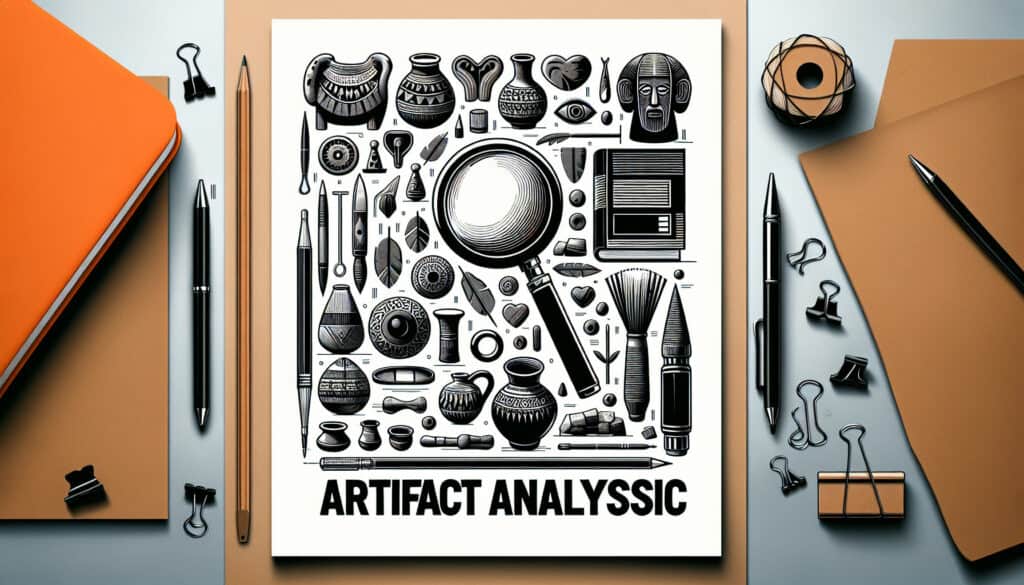Une recherche méthode qui implique l'examen systématique des objets matériels ou "artefacts" d'une culture ou d'un groupe.
- Méthodologies : Ergonomie
Analyse des artefacts

Analyse des artefacts
- Expérience client, Conception pour la durabilité, Pensée conceptuelle, Interaction homme-machine, Conception d'interaction, Utilisabilité, Tests d'utilisabilité, Expérience utilisateur (UX), User-Centered Design
Objectif :
Comment il est utilisé :
- Dans le domaine de l'interaction homme-machine et de la conception, l'analyse des artefacts est utilisée pour comprendre comment les gens utilisent la technologie dans leur vie quotidienne. En examinant les objets que les gens utilisent, les chercheurs peuvent se faire une idée de leurs besoins, de leurs valeurs et de leurs pratiques.
Avantages
- Elle permet une compréhension riche et contextualisée du comportement des utilisateurs, peut mettre en évidence des besoins et des opportunités qui ne sont pas révélés par d'autres méthodes de recherche, et peut être utilisée pour informer la conception de nouveaux produits et services.
Inconvénients
- Elle peut prendre du temps, nécessite un analyste qualifié et l'interprétation des données peut être subjective.
Catégories :
- Clients et marketing, Conception de Produits
Idéal pour :
- Comprendre le comportement et les besoins des utilisateurs en examinant les objets qu'ils utilisent.
L'analyse des artefacts est couramment employée dans différentes phases du développement de produits, en particulier lors des premières étapes de l'idéation et de la recherche sur les utilisateurs, où la compréhension des interactions du monde réel avec la technologie est primordiale. Cette méthodologie est particulièrement adaptée aux industries telles que l'électronique grand public, la conception automobile et la technologie des soins de santé, où l'expérience de l'utilisateur influe considérablement sur le succès du produit. Les participants à l'analyse des artefacts sont généralement des concepteurs, des anthropologues, des chercheurs en utilisabilité et des ingénieurs, qui collaborent pour identifier les comportements et les préférences nuancés des utilisateurs qui influencent les choix de conception. Une application notable de l'analyse des artefacts se trouve dans le domaine des soins de santé, où l'analyse de l'utilisation des dispositifs médicaux dans les environnements cliniques permet de découvrir les inefficacités et les points de douleur des utilisateurs qui peuvent ne pas être apparents dans les méthodes d'enquête traditionnelles. En outre, cette approche peut contribuer à l'innovation des technologies domestiques intelligentes en permettant aux développeurs d'étudier la manière dont les utilisateurs interagissent avec les appareils domestiques tels que les haut-parleurs et les thermostats intelligents, révélant ainsi des possibilités d'amélioration de l'intégration et de la convivialité. En documentant et en analysant les artefacts et les contextes d'utilisation, les équipes peuvent développer une compréhension plus empathique des défis posés par les utilisateurs, ce qui permet d'améliorer l'efficacité et la facilité d'utilisation. centré sur l'utilisateur des solutions de conception. L'examen approfondi des artefacts, combiné à des études d'observation, peut également mettre au jour les influences culturelles sur l'adoption des technologies, ce qui en fait une approche inestimable pour la conception de produits à l'échelle mondiale.
Principales étapes de cette méthodologie
- Identifier et sélectionner les artefacts pertinents pour l'expérience utilisateur étudiée.
- Procéder à un examen détaillé des objets choisis, en se concentrant sur leur conception, leur fonctionnalité et leur contexte d'utilisation.
- Analyser la manière dont les utilisateurs interagissent avec les artefacts, y compris leurs comportements, leurs défis et leurs niveaux de satisfaction.
- Recherchez des modèles d'utilisation, en notant tout écart entre le comportement attendu et le comportement réel.
- Interpréter les résultats en fonction des besoins, des valeurs et des flux de travail des utilisateurs.
- Générer des implications en matière de conception sur la base de l'analyse, en identifiant les possibilités d'innovation ou d'amélioration.
Conseils de pro
- Se concentrer sur le contexte social entourant les artefacts ; comprendre comment les communautés interagissent avec ces objets révèle des valeurs et des normes culturelles plus profondes.
- Intégrer des études longitudinales dans l'analyse des artefacts ; cette approche permet de saisir l'évolution des interactions au fil du temps et d'identifier les besoins changeants des utilisateurs.
- Exploiter les techniques ethnographiques parallèlement à l'analyse des artefacts ; l'observation des utilisateurs dans leur environnement naturel offre des perspectives nuancées qui enrichissent les résultats.
Lire et comparer plusieurs méthodologies, nous recommandons le
> Référentiel méthodologique étendu <
ainsi que plus de 400 autres méthodologies.
Vos commentaires sur cette méthodologie ou des informations supplémentaires sont les bienvenus sur le site web de la Commission européenne. section des commentaires ci-dessous ↓ , ainsi que toute idée ou lien en rapport avec l'ingénierie.
Contexte historique
1986
(si la date est inconnue ou n'est pas pertinente, par exemple "mécanique des fluides", une estimation arrondie de son émergence notable est fournie)

Articles Similaires
Gestion des opérations de fabrication (MOM)
Système d'exécution de la fabrication (MES)
Plan de contrôle de la fabrication
Tests manuels
Tableaux d'évaluation des manutentions manuelles (MAC)
ManTRA (outil d'évaluation des risques liés aux tâches manuelles)